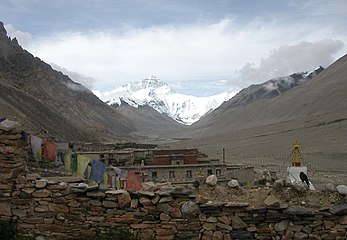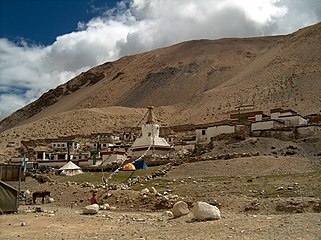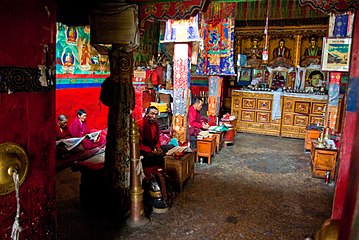Rongbuk Monastery
| Rongbuk Monastery | |
|---|---|
Tibetan: རྫ་རོང་ཕུ་དགོན་ Wylie transliteration: rdza rong phu dgon | |
 Mount Everest as seen from the Rongbuk Monastery | |
| Religion | |
| Affiliation | Tibetan Buddhism |
| Sect | Nyingma |
| Location | |
| Location | Basum Township |
| Country | China |
| Geographic coordinates | 28°11′47″N 86°49′40″E / 28.19639°N 86.82778°E |
| Architecture | |
| Founder | Ngawang Tenzin Norbu |
| Date established | 1902 |
Rongbuk Monastery (
Location
Rongbuk Monastery lies near the base of the north side of
Today, the monastery is accessible by road after a two- to three-hour drive from the
Architecture
In front of the Monastery, there is a large, round, terraced chorten containing a reliquary.
-
Rongbuk monastery in August 2005, with North Face of Mount Everest
-
chorten in Rongbuk
-
Chorten with prayer flags and the North Face of Mount Everest
-
Rongbuk monastery in August 2005, Mount Everest in the background
-
Monastery arch
-
Building construction with stone and clay
-
Stone buildings
History, religious and cultural significance
Rongbuk Monastery was founded in 1902 by the
The founding Rongbuk Lama, also known as Zatul Rinpoche, was much respected by the Tibetans. Even though the Rongbuk Lama viewed the early climbers as "heretics," he gave them his protection and supplied them with meat and tea while also praying for their conversion. It was the Rongbuk Lama who gave Namgyal Wangdi the name Ngawang Tenzin Norbu, or Tenzing Norgay, as a young child.[citation needed]
In previous times, the Monastery became very active with Buddhist teachings at certain times of the year. It was, and is, the destination of special Buddhist pilgrimages where annual ceremonies are held for spectators coming from as far away as Nepal and Mongolia. These ceremonies were shared with satellite monasteries across the Himalaya also founded by the Rongbuk Lama. These ceremonies continue to this day, notably at the Sherpa Monastery at Tengboche.[citation needed]
Rongbuk Monastery was completely destroyed by the excesses of China's Cultural Revolution (1966-1976) by 1974, and was left in ruins for several years, as recorded by photo-journalist Galen Rowell in 1981.[10]
The monastery's vast treasury of books and costumes, which had been taken for safekeeping to Tengboche, was lost in a 1989 fire.[citation needed]
Since 1983 renovation work has been carried out and some of the new murals are reportedly excellent. Adjacent to the monastery there is a basic guesthouse and small but cosy restaurant.[11]
According to Michael Palin, it now houses thirty Buddhist monks and thirty nuns,[12] but another source reports that locals say there are only about 20 nuns and 10 monks, although previously there were about 500 monks and nuns living here.[11]
In 2011, Rongbuk Monastery was ranked at the top of CNN's 'Great Places to be a Recluse'.[13]
-
A view of the modest Rongbuk Monastery with yaks in the foreground[14]
-
Monks in Rongbuk Monastery
-
Rongbuk Monastery Near Basecamp
-
view of Mount Everest
References
- ^ "Rongphuk Monastery and the Everest Region". www.colorado.edu. Archived from the original on 1 December 2017. Retrieved 25 June 2018.
- Tibetan in Wylie transliteration: dpa’ gsum; simplified Chinese: 巴松乡; traditional Chinese: 巴松鄉; pinyin: Bāsōng Xiàng
- ISBN 1-903471-30-3.
- ^ a b Chan, Victor (1994). Tibet Handbook: A Pilgrimage Guide. Moon Publications.
- ISBN 0-297-84371-0.
- ^ "The Highest Monasteries in Tibet – Why Rongbuk is not the Highest Monastery in the World_Destination_China Tibet Online". eng.tibet.cn. Retrieved 2022-01-20.
- ^ Tenzing Norgay and James Ramsey Ullman, Man of Everest (1955, also published as Tiger of the Snows)
- ISBN 0-340-49092-6.
- ^ Early 18th century according to Victor Chan or the late 18th century according to Gyurme Dorje
- ^ "Rongphuk Monastery and the Everest Region". Archived from the original on 2002-11-21. Retrieved 2010-01-11.
- ^ ISBN 1-74059-523-8.
- ^ Palin, Michael (2004). "Himalaya with Michael Palin". Himalaya with Michael Palin (Documentary). Episode 3: Annapurna to Everest. Britain: BBC. Event occurs at 48 minutes 6 seconds. Retrieved 9 June 2019.
- ^ So, Winnie. "9 great places to be a recluse". CNN.
- ^ "Guide to Tibet - Things to do, Places to go and Practicalities". 14 June 2017.
External links
- Rongbuk Monastery, NOVA.













![A view of the modest Rongbuk Monastery with yaks in the foreground[14]](http://upload.wikimedia.org/wikipedia/commons/thumb/a/a2/Rongbuk_Monastery_with_yaks.jpg/361px-Rongbuk_Monastery_with_yaks.jpg)


